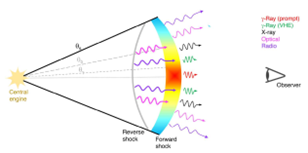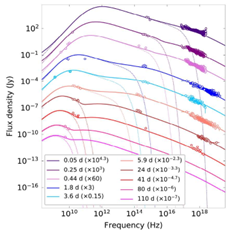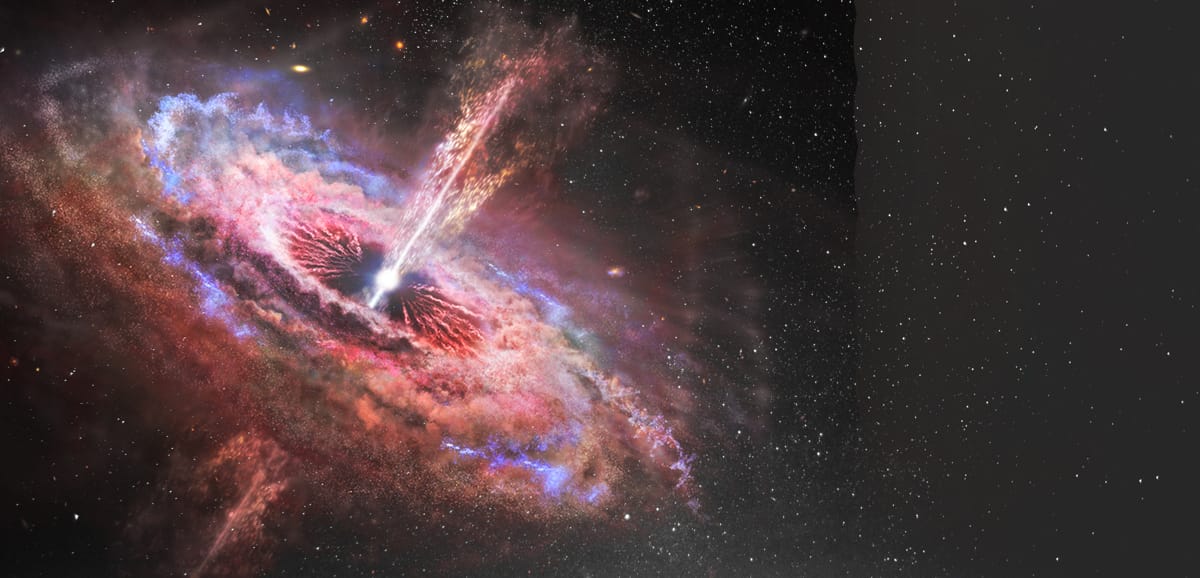The ultrarelativistic (moving at extremely close to the speed of light) jets in Gamma-ray bursts (GRBs) are launched by a rapidly spinning central compact source – a black hole or a magnetar (a highly magnetized, rapidly spinning neutron star). GRBs divide into two classes – short duration GRBs (sGRBs, whose gamma-ray emission lasts less than about two seconds) that are created by the merger of two neutron stars or a neutron star and a black hole, and long duration GRBs (lGRBs, whose gamma-ray emission lasts more than about two seconds) that are produced by the explosion of particularly massive and rapidly spinning stars. It has been known for some time that the angular structure of lGRB jets must be affected by their interaction with the exploding progenitor star’s envelope as the jet bores a hole through it and breaks out. This is well corroborated by advanced numerical simulations.
What is not well known is the exact angular structure these jets possess after they break out.
The jet sweeps up the surrounding medium, driving a strong relativistic shock into it, producing long-lived (up to weeks, months or even years) multi-wavelength (from radio to high-energy gamma rays) afterglow emission by synchrotron radiation in the shocked external medium. This afterglow emission encodes vital information about the jet’s angular structure, which can help unravel it. Most afterglows are well explained as arising from a uniform conical jet with sharp edges. The existence of sharp edges is revealed through a phenomenon called a “jet break” , a steepening of the afterglow lightcurve (an increase in the flux decay rate) when emission from the jet edges reaches us. The sharpness of this break also depends on the radial density profile of the surrounding external medium (which may decrease with distance for the pre-explosion stellar wind of the progenitor massive star).
A puzzling feature that has been seen in some of the bright GRBs is that the jet break is much shallower than what is expected from theoretical models of a sharp-edged conical jet. One explanation for this behavior is that the jet does not have sharp edges, and instead it has smooth extended “wings” where its energy per solid angle very gradually decreases with the angle from the jet’s symmetry axis, dubbed “shallow jets”. Such an angular profile may be described by the jet having a narrow core surrounded by wings where the energy per solid angle and Lorentz factor gradually drop as a power law with the angle from the jet’s symmetry axis.
Thus far, lGRB afterglow observations did not offer any clear evidence to substantiate the presence of any angular structure. This changed on October 10, 2022 when an extremely luminous GRB 221009A was detected by a number of X-ray and gamma-ray detectors in space. Its gamma-ray emission lasted over 600 seconds, and had an isotropic-equivalent gamma-ray energy upwards of 1E55 erg, the largest energy detected for any GRB ever! In addition, it was also relatively close to the Earth (“only” 2.4 billion lightyears), leading to a huge energy fluence, about a hundred times larger than the previous record holder. This garnered the GRB the title of the B.O.A.T (brightest of all time) burst. Not only that, the burst was also very bright in TeV gamma-rays, where the Large High Altitude Air Shower Observatory (LHAASO) on the ground detected more than 64,000 (>0.2)TeV photons, which is unprecedented.
The afterglow of GRB 221009A also showed a shallow achromatic break in the lightcurve, where the achromatic nature is indicative of a geometric, rather than spectral, effect caused by the jet’s angular structure. Several works tried to explain the multi- waveband afterglow lightcurve using canonical models of a uniform conical jet, but they were unable to explain some key features including the shallow break and especially the radio afterglow lightcurve.


Fig. 1: (Left) The angular structure of the jet featuring a narrow uniform core with angular size θγ surrounded by power-law wings in energy with a shallow break at angle θb. Two emission components are realized, with X-rays coming from the shocked matter behind the forward shock and radio emission from the shocked matter behind the reverse shock. (Right) Multiwaveband (Radio, optical, X-ray) model spectral fit from the two emission components to afterglow observations at different times. The dotted curves show the contribution from the reverse shock.
An important revelation that explained these two key features was made in a study published in the journal Science Advances (O’Conner et al. 2023, Sci. Adv., 9, eadi1405) by an international team of researchers, that included three members of the ARCO (Paz Beniamini, Jonathan Granot, and Ramandeep Gill) who made important contributions to the study. This work showed that an ultrarelativistic structured jet with a uniform narrow core surrounded by shallow power-law wings in energy (see left panel of Fig.1), and that is viewed close to the jet core boundary, is the best explanation for the shallow jet break in the afterglow lightcurve. Furthermore, it argued that the X-ray afterglow is entirely powered by emission coming from shocked external matter behind the forward (i.e. afterglow) shock, while the radio afterglow is dominated by emission from the reverse shock that decelerates the original GRB jet material.
The above work featured all of the important ingredients but lacked self-consistency in that the reverse shock region was assumed to be uniform in energy (per solid angle), different from the angular structure assumed for the forward shock region, and the dynamical evolution of the two regions was uncoupled.

Fig. 2: (Left) Multiwaveband model spectral fit to afterglow observations of GRB 221009A. The solid curve shows the total spectrum that constitutes emission from the forward shock (dashed line) and the reverse shock (dotted line). (Middle) Model spectral fit to the radio afterglow shown at different times. (Right) Model lightcurve fit to the afterglow lightcurve, shown for different energies.
This shortcoming in the model was addressed in a follow-up study, now published in MNRAS Letters (Gill & Granot, 2023, MNRAS, 524, L78), by the ARCO members Ramandeep Gill and Jonathan Granot. This work presented a more self-consistent afterglow model that calculated the coupled dynamical evolution of the forward and reverse shocked regions while assuming a common shallow angular structure, in both energy (per solid angle) and bulk Lorentz factor, for both regions. This kind of semi-analytical afterglow model that features a jet with angular structure had never been used for comparison with observations. This study confirmed the jet angular structure assumed in the earlier paper by O’Conner et al. 2023, and definitively showed that the radio afterglow emission is indeed produced by the reverse-shock heated original jet material and even that emission requires the jet to have angular structure.
The unprecedented multi-waveband afterglow observations of the extremely bright GRB 221009A, and the theoretical models put forth in the two works to explain the afterglow, have advanced our understanding of GRB jets. They have shown that many bright GRBs that show a shallow achromatic steepening in their afterglow lightcurves can be explained by the jets having a shallow energy angular structure, which is more realistic and also expected on theoretical grounds and from numerical simulations of powerful GRB jets breaking out of the stellar envelopes of their progenitor stars.





